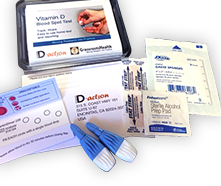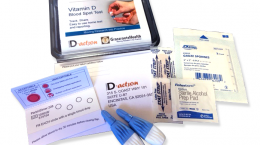Published on January 2, 2023
These markers can be utilized for achieving and maintaining better health. Measure them to know your status today, and learn what steps to take to improve them, and your health, this year!

It’s the beginning of a new year, a time when new goals are set and the first steps are taken towards achieving those goals. One goal at the forefront of everyone’s mind is how to be and stay healthy. GrassrootsHealth has several tools to help you achieve that goal – the first being our home blood spot testing and education opportunity!
Enrolling to measure your current status of these important nutrients and health markers is the first step you can take this year in taking charge of your health.
What Markers Can You Measure?
Regardless of where you want to keep your nutrient levels, and those of other health markers, it is essential that you measure to know where you are now. We have seen with several nutrients that there is a wide range of variability in how a person responds to supplementation (or sun exposure in the case of vitamin D). What works for one person may not work well for another. The only way to know where you stand is to measure.
We now have several testing options; all test kits include vitamin D and you may choose to add any of the additional tests using our custom kit builder.
Vitamin D – This hormone is essential for the proper functioning of several systems within our body, including how our cells read and express our DNA. The most accurate measurement of vitamin D status can be determined by measuring the amount of 25(OH)D in the blood. Anywhere between 40-75% of the world’s population is vitamin D deficient. Our panel of 48 International Scientists recommends a vitamin D level of 40-60 ng/ml. Are you within that recommended range?
Omega-3 Index – Omega-3s play an important role in cardiovascular, reproductive, cognitive, and emotional health, and are linked to improved mortality and healthier aging. The Omega-3 Index is a measure of the amount of the omega-3 fatty acids, eicosapentaenoic acid (EPA) and docosahexaenoic acid (DHA), in red blood cell (RBC) membranes. The result is expressed as a percent of total RBC fatty acids, and is a long-term and stable marker of omega-3 status throughout the blood and tissues. The target recommended by experts is a minimum of 8%.
ADD the AA:EPA and Omega-6:Omega-3 Ratios to the Omega-3 Index for additional information about your balance of omega-6 fatty acids to omega-3s. The AA:EPA Ratio test measures the ratio of the amount of the omega-6 fatty acid arachidonic acid (AA) and the omega-3 fatty acid eicosapentaenoic acid (EPA) in the cells. This test can be an indication of the amount of cellular inflammation in the body, since AA is pro-inflammatory and EPA is anti-inflammatory. The Omega-6:Omega-3 ratio is calculated by dividing the sum of seven omega-6 fatty acids by the sum of four omega-3 fatty acids, and is another way to measure the balance of fats in the body.
Magnesium – One of the most important minerals in the body, magnesium is essential for energy production. Magnesium is also important for your brain and bone health, blood glucose control, DNA and genetic material, blood pressure, detoxification processes and for helping activate vitamin D in your body. It’s believed that about 80% of Americans don’t get enough, and as you age, your body becomes less efficient at absorbing magnesium. This whole blood magnesium test measurement includes the amount of magnesium in your blood cells as well as the plasma/serum, which is a better indicator of magnesium status than the serum magnesium test offered by most doctor’s offices and hospitals.
Elements Panel (Includes Magnesium) – It is important for essential elements to be within their normal or optimal range in order to fulfill their roles in maintaining health. When an essential element is out of range, it can lead to disease or sub-optimal functioning. Some essential elements, such as selenium, copper and zinc, can become toxic when they are too high. Toxic elements, such as lead, cadmium, and mercury, have no known nutritional benefit and are known to interfere with proper functioning of proteins, lipids, and DNA within the cells. They can also interfere with essential elements by blocking their availability within the body. This panel measures your levels of essential elements magnesium, copper, selenium and zinc, as well as toxic elements lead, cadmium and mercury.
C-Reactive Protein (hsCRP) – hsCRP is a marker of the amount of inflammation in the body. High levels are seen in acute inflammation and have been correlated with high cardiovascular disease risk, while smaller elevations are often indicative of chronic inflammation and chronic diseases, such as metabolic syndrome and diabetes.
Hemoglobin A1c (HbA1c) – HbA1c is a measure of average blood sugar levels in the recent few months, and is a better representation of blood sugar health than a single glucose measurement, since glucose levels vary throughout the day. HbA1c is the compound formed in the blood when a hemoglobin molecule in a red blood cell binds with a glucose molecule in the blood; the resulting molecule is also known as glycated hemoglobin. It can be a good indicator of glucose intolerance even in the absence of abnormal fasting glucose levels.
Thyroid Stimulating Hormone (TSH) – TSH is considered the most sensitive marker for thyroid screening, and is necessary for the stimulation of the thyroid gland and production of thyroid hormones. When the thyroid is taxed or under-active (such as in hypothyroidism), TSH levels increase in an effort to further stimulate thyroid function and the production of thyroid hormones. Even a borderline-underactive thyroid is associated with certain health concerns, such as fatigue, unexplained weight gain, infertility, and mood swings.
NEW! Type 1 Diabetes (T1D) Autoantibodies – Autoantibodies are antibodies created by a person’s immune system that attack proteins in their own cells, as seen in many autoimmune diseases. The presence of the T1D islet cell autoantibodies indicates an autoimmune response against the cells of the pancreas, and is strongly associated with the development of T1D; the detection of these autoantibodies can be used as markers of the process that can cause type 1 diabetes. According to the American Diabetes Association, the presence of two or more of these autoantibodies in the blood, but with normal blood glucose levels, defines Stage 1 Type 1 Diabetes. **This does not mean that a person with two or more of these autoantibodies in fact has Type 1 Diabetes**
The presence of autoantibodies can change over time, and can be influenced by factors such as the status of the body’s immune system and levels of inflammation. Improved vitamin D and omega-3 status, as well as decreased inflammation, have been associated with lower levels of these autoantibodies and therefore lower risk of T1D development.
T1D autoantibodies tested for as part of the Type 1 Diabetes Prevention project include
- Anti-Insulin (also known as mIAA or IAA)
- Anti-IA2 (IA-2A)
- Anti-GAD65 (GAD65 or GADA)
- Anti-ZnT8 (ZnT8)
What Are Your Levels of the Above? Measure Today!
 Having and maintaining healthy omega-3 and vitamin D levels can help improve your health now and for your future. Choose which markers to measure along with vitamin D, such as your omega-3s and essential minerals including magnesium and zinc, by creating your custom home test kit today. Take steps to improve the status of each of these measurements to benefit your overall health. You can also track your own intakes, symptoms and results to see what works best for YOU.
Having and maintaining healthy omega-3 and vitamin D levels can help improve your health now and for your future. Choose which markers to measure along with vitamin D, such as your omega-3s and essential minerals including magnesium and zinc, by creating your custom home test kit today. Take steps to improve the status of each of these measurements to benefit your overall health. You can also track your own intakes, symptoms and results to see what works best for YOU.
Enroll and test your levels today, learn what steps to take to improve your status of vitamin D (see below) and other nutrients and blood markers, and take action! By enrolling in the GrassrootsHealth projects, you are not only contributing valuable information to everyone, you are also gaining knowledge about how you could improve your own health through measuring and tracking your nutrient status, and educating yourself on how to improve it.






